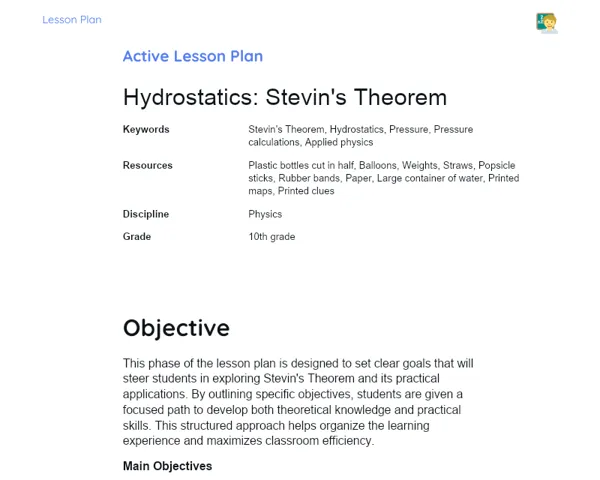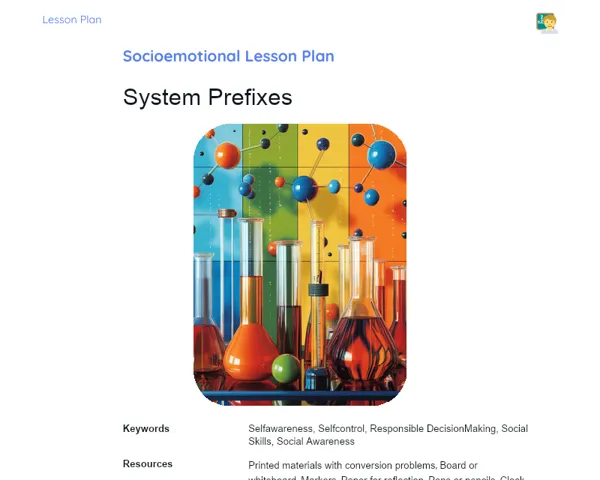Lesson Plan | Socioemotional Learning | Vectors: Introduction
| Keywords | Vectors, Physics, 9th Grade, Magnitude, Direction, Sense, Cartesian Plane, Mindfulness, RULER, Self-awareness, Self-regulation, Responsible Decision Making, Social Skills, Social Awareness, Practical Activity, Group Discussion, Reflection, Emotional Regulation |
| Resources | Graph paper, Ruler, Calculator, Pencil, Eraser, Whiteboard, Markers, Notepaper |
| Codes | - |
| Grade | 10th grade |
| Discipline | Physics |
Objective
Duration: 10 to 15 minutes
This stage aims to provide a clear and engaging introduction to vectors, preparing students for a comprehensive and practical understanding of the topic. By outlining specific objectives, the teacher ensures that students are clear on what is expected of them, fostering engagement and aiding the organization of subsequent activities. Additionally, this stage helps students start to familiarize themselves with fundamental concepts, laying a strong foundation for developing socioemotional skills throughout the lesson.
Objective Utama
1. Explain the concept of a vector, including its components: magnitude, direction, and sense.
2. Demonstrate how to calculate the magnitude of a vector using relatable examples.
3. Teach how to represent a vector in the Cartesian plane.
Introduction
Duration: 15 to 20 minutes
Emotional Warmup Activity
✨ Mindfulness: Focus and Presence ✨
Mindfulness is a technique that helps students focus on the present moment. By practicing mindfulness, students learn to observe their emotions and thoughts without judgment. This practice encourages calmness and mental clarity, both vital for effective learning.
1. Ask students to sit comfortably with their feet flat on the ground and hands resting on their laps.
2. Guide them to close their eyes or focus softly on a point in front of them.
3. Instruct them to take three deep breaths, inhaling through the nose and exhaling slowly through the mouth.
4. Lead them into a short meditation, directing their focus to their breathing. For example, say: 'Notice the air flowing in and out. Observe the rise and fall of your chest.'
5. If thoughts or feelings surface, encourage them to acknowledge and let go, returning their focus to their breath.
6. After around 5 minutes, invite them to slowly open their eyes and stretch if needed. Ask how they feel and encourage sharing their experiences if they wish.
Content Contextualization
Vectors are crucial tools in physics and various other sciences as they describe quantities that have direction and magnitude, such as force, velocity, and acceleration. Understanding vectors is key to solving real-life problems, like figuring out the best route for a journey or interpreting wind direction for outdoor sports.
Furthermore, working with vectors enhances essential cognitive and emotional skills, such as responsible decision-making and problem-solving abilities. By learning about vectors, students gain not only technical insight but also build self-confidence and social skills through collaborative activities and group discussions.
Development
Duration: 60 to 75 minutes
Theory Guide
Duration: 20 to 25 minutes
1. Definition of a Vector: A vector is a mathematical entity with magnitude (length), direction, and sense. It is visually represented by an arrow.
2. Components of a Vector: The three main components of a vector are: Magnitude: the length or quantity represented by the vector. Direction: the vector's orientation in space. Sense: the arrow's orientation, indicating where the vector points.
3. Practical Example: Think about pushing a shopping cart. The force you apply can be depicted as a vector. The magnitude represents the strength of the force, the direction is the path the cart takes, and the sense tells you where you are pushing.
4. Calculating the Magnitude of a Vector: For a vector v = (x, y) in the Cartesian plane, the magnitude is calculated using the formula: [ |v| = \sqrt{x^2 + y^2} ] Example: If v = (3, 4), then the magnitude is: [ |v| = \sqrt{3^2 + 4^2} = \sqrt{9 + 16} = \sqrt{25} = 5 ]
5. Representation of Vectors in the Cartesian Plane: A vector v = (x, y) is illustrated as an arrow starting from the origin (0, 0) to the point (x, y). Example: The vector v = (3, 4) is shown by an arrow beginning at the origin and terminating at the point (3, 4).
6. Analogies and Comparisons: Compare vectors to directions on a map, where magnitude represents the distance to be traveled, direction indicates the route to take, and sense reveals the movement's orientation. Use everyday scenarios, like a car’s speed, to demonstrate how vectors are relevant in various real-life contexts.
Activity with Socioemotional Feedback
Duration: 25 to 30 minutes
📏 Vectors in Practice: Creating and Calculating 📏
During this activity, students will use theoretical concepts about vectors to tackle practical situations. They will work in groups to sketch vectors on the Cartesian plane, compute magnitudes, and analyze the direction and sense of the vectors.
1. Divide the students into groups of 3 to 4.
2. Provide graph paper and a ruler to each group.
3. Instruct each group to draw three different vectors on the graph paper, specifying starting and ending coordinates.
4. Ask students to calculate the magnitude of each vector using the given formula.
5. Request that the groups identify the direction and sense of each vector they drew.
6. Then, have each group exchange their drawings with another group to check the calculations and the representations made.
Discussion and Group Feedback
After completing the practical activity, hold a group discussion using the RULER method. Recognize: Ask students how they felt during the activity and how they recognized their emotions when encountering difficulties. Understand: Discuss the reasons behind the emotions felt, like frustration from mistakes or satisfaction from success. Label: Encourage students to articulate their feelings accurately, such as joy, frustration, anxiety, among others. Express: Guide students in expressing these emotions appropriately by sharing their experiences with peers. Regulate: Collaborate on emotional regulation techniques, like deep breathing and peer support, to process negative emotions and reinforce positive experiences.
This discussion will aid students in reflecting on their emotional experiences during the activity, enhancing their self-awareness and self-control. Moreover, sharing experiences helps them develop social skills and awareness, fostering empathy and teamwork.
Conclusion
Duration: 10 to 15 minutes
Reflection and Emotional Regulation
Encourage students to write a short paragraph or take part in a group discussion regarding the challenges faced during the lesson. Ask how they felt when drawing and calculating the vectors, and how they coped with emotions amidst difficulties. Motivate them to reflect on the strategies they employed to overcome those challenges and how they can use those lessons in future scenarios.
Objective: This subsection aims to promote self-assessment and emotional regulation, guiding students to identify effective strategies for managing challenging situations. By reflecting on their emotions and actions, students enhance their self-awareness and self-control, which are crucial for personal and academic growth.
Glimpse into the Future
Highlight the importance of setting personal and academic goals in relation to the lesson content. Instruct each student to jot down one or two specific goals they wish to achieve regarding vectors in the upcoming weeks. Goals may include improving accuracy in vector calculations or enhancing collaboration with classmates during group tasks.
Penetapan Objective:
1. Improve the precision of vector calculations.
2. Collaborate more effectively with peers during group tasks.
3. Deepen understanding of how vectors apply in everyday situations.
4. Build confidence in solving physics problems involving vectors. Objective: The aim here is to reinforce students' independence and the practical application of their learning, encouraging continued academic and personal development. By setting clear goals, students can maintain focus and motivation, leading to a more effective and meaningful learning experience.


